Fire! — Understanding What’s Happening in Your Combustion Appliances
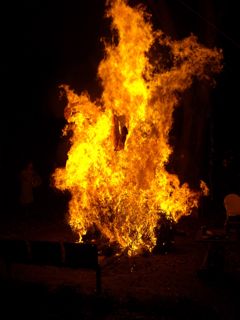
 Fire is just so dang interesting! Its discovery by our early ancestors changed the lives of humans forever. Who doesn’t love a good fire?! When I was about 8 years old, I got so fascinated with it that Bubba, my friend from next door in Houston, and I were experimenting with it in my garage one day, setting a fire in our clothes dryer. The next day we took our act up to the big field at the end of the street and ended up setting it on fire. The fire trucks came, and everyone in the neighborhood came out to watch as the fire department doused our creation with water. My mom was not amused.
Fire is just so dang interesting! Its discovery by our early ancestors changed the lives of humans forever. Who doesn’t love a good fire?! When I was about 8 years old, I got so fascinated with it that Bubba, my friend from next door in Houston, and I were experimenting with it in my garage one day, setting a fire in our clothes dryer. The next day we took our act up to the big field at the end of the street and ended up setting it on fire. The fire trucks came, and everyone in the neighborhood came out to watch as the fire department doused our creation with water. My mom was not amused.
Fire is just so dang interesting! Its discovery by our early ancestors changed the lives of humans forever. Who doesn’t love a good fire?! When I was about 8 years old, I got so fascinated with it that Bubba, my friend from next door in Houston, and I were experimenting with it in my garage one day, setting a fire in our clothes dryer. The next day we took our act up to the big field at the end of the street and ended up setting it on fire. The fire trucks came, and everyone in the neighborhood came out to watch as the fire department doused our creation with water. My mom was not amused.
Also, someone back in history decided that fire was one of the four elements that made up everything in the universe: earth, air, fire, and water. In the modern world we live in, fire is still one of the four elements:
The four building blocks of the universe are fire, water, gravel and vinyl.
~ Dave Barry
Your home may well have some fires burning in it. If you have a gas water heater, furnace, oven, or other type of combustion appliance, you’ve got fire. Do you understand what’s going on inside, though, and what are the needs of your fiery contraptions? Well, that’s today’s topic, so let’s take a look at the basics of combustion.
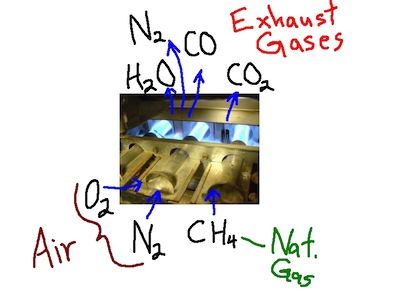
When the fire is burning inside your furnace or water heater, the two main combustion appliances in homes, it’s combining air with natural gas. Air is about 80% nitrogen and 20% oxygen. Natural gas is mostly methane, which is one carbon bonded to 4 hydrogens. It’s a hydrocarbon, one of the simplest, in fact.
The burner in your combustion appliance mixes the air and gas together and provides the spark for the chemical reaction to occur and voilà — You have fire! When the air and gas burn, you get heat and exhaust gases. The heat is what you’re after. The exhaust gases are what you need to get rid of.
The actual reaction that gives you the heat doesn’t involve the nitrogen. Even though it’s the majority of the air that goes in, it mostly just passes right through. When everything is operating properly, you get complete combustion, and the chemical equation looks like this:
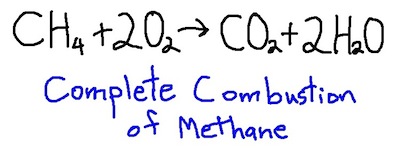
Your combustion appliances are set up to mix enough air with the gas so that the combustion is always complete. In fact, because the temperature and pressure of the air in your home changes, thus affecting how much oxygen gets delivered, the combustion appliance is set up to deliver excess air.
If things go bad and incomplete combustion occurs, that’s when you get carbon dioxide’s evil cousin, carbon monoxide, CO. You don’t want that. With natural gas, the combustion is usually complete when everything is working properly, and there will be little to no carbon monoxide in the exhaust gases. When things don’t work perfectly, a little bit of carbon monoxide in the exhaust gases isn’t a problem as long as the heat exchanger and flue are intact and get all the exhaust out of the house.
So, that’s it. Your combustion appliances take air and fuel and turn them into heat and exhaust gases. I’ve shown the details of what happens with natural gas, but the process is similar for propane, fuel oil, kerosene, and wood. In future articles, we’ll look at what happens to the heat, the dangers of carbon monoxide, and different types of combustion appliances.
Speaking of fire, the holiday season is here now, and that makes me start looking forward to Possum Drop and the bonfire that consumes the sacrificial possum to ring in the new year. Here’s a photo from a couple years ago.
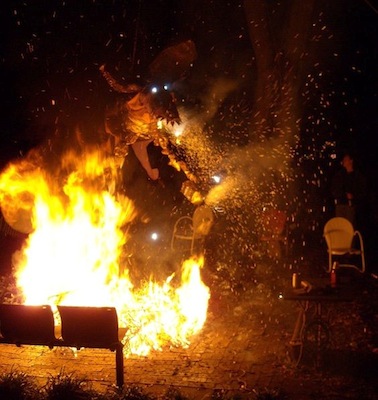
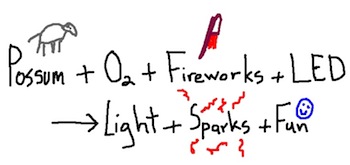
This Post Has 5 Comments
Comments are closed.

Having trouble balancing
Having trouble balancing chemical equation for complete combustion of possum. Please advise.
Gunther:
Gunther: Yeah, from that photo, I can see why you might be a little confused. The secret ingredients for this reaction are fireworks and, that year, LED flashlights. Check out the equation I added below the possum.
Natural Gas, unlike other
Natural Gas, unlike other fuels will burn with very close to no CO if there is enough air and no impingement on a surface.
While it is important to keep CO (and NOx etc.) out of your house, the first line of defense is to avoid creating CO. There are two steps in chronic CO problems (as well as fatal CO problems). 1) CO is created by incomplete combustion and 2) the combustion products are not venting out of the structure. We should avoid both 1 and 2.
John P.:
John P.: Thanks! I’ve clarified the third to last paragraph.
I still say the dropping
I still say the dropping Possum reminds me an awful lot of the Pink Floyd (“Animals”) concert pig, especially the glowing eyes….